#glamblogclub
Text
Top 5 museum weirdness
Received any weird requests recently? Here are some of my favourites from the 1970s received by the National Museum of Victoria and documented in the Museums Victoria Archives.
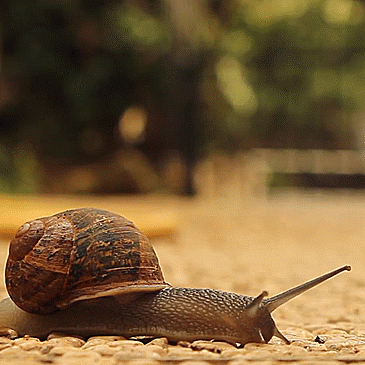
No. 5
“The Invertebrate Department received a call from a person who wanted to know how he could make his snail “go faster” - prior to the commencement of a snail race!”
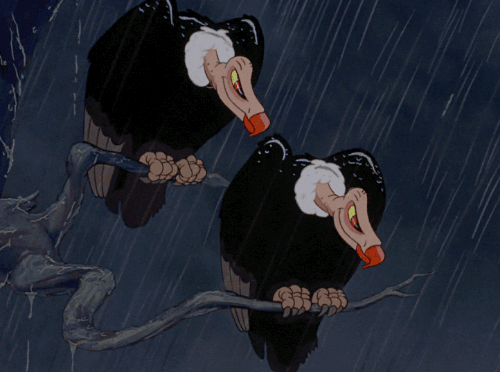
No. 4
“Lorene Reid in Ornithology received a weird request. A woman phoned and said “do you have a stuffed vulture?” Lorene said “no, I am sorry we do not have one”. The woman then said, “What a pity, I wanted one for a birthday present!”
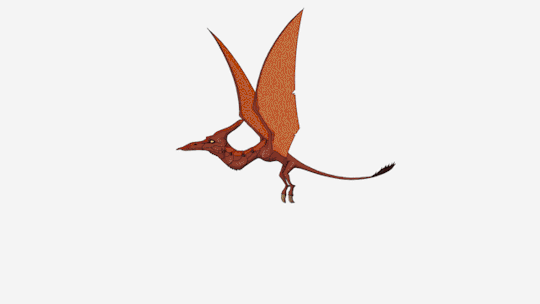
No. 3
The museum received a letter: “Would like to say I am utterly impressed with the new improvements to the museum. I think it is much cleaner and much easier to follow. The observatory cases are made with a much better design. But ever since I was six, four years ago, I have envied the Pterodactyl (prehistoric bird) on the roof of the hall at the main entrance. And seeing you are re-doing a lot of the museum if you ever have to get rid of the bird would you put me first on the list.”
No. 2
A weird donation offer via a letter: “My grandparents found or were given this yabbie (or whatever) by a driller in Central Australia. I don’t know where or at what depth. Anyway, they cherished this greatly and gave it to me. I’m afraid I value it very little, but have scruples about throwing it away. I thought I might overcome these feelings if I gave it to you and let you throw it away instead. Then I can tell them that I’ve given it to the Museum. They would be pleased! ... Sorry for passing the buck, but I’m sure they’ll like the explanation for its absence from this household. Thank you.”
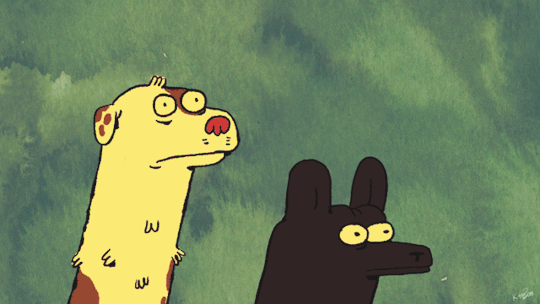
No.1
“A woman phoned the office for someone to bark like a dog. Kevin Bent was appointed “Official” dog-barker on this occasion. The woman wanted the Museum to verify that her brown Magpie barked. But the secret was that the magpie had to hear a barking sound first. So what else could Kevin do to help the public? He made several attempts to get it just right... Grr... Grr-rrr... Ruff... Grrr... and then finally a barking sound came back at him through the phone (presumably from the magpie). The woman was happy.”
2 notes
·
View notes
Text
Evaluation of Donation

In all honesty, I was a little bit shocked when first learnt that libraries didn't necessarily dig random donations. I mean, now I have a much better understanding of collection development, I can see why it would be a jerk. But seriously, the GLAM is all about collecting stuff and therefore having more stuff should be the aim of the game.
I can remember sneaking into a Museum Vic presentation about assembling a 'significant' collection for small/community institutions and it kinda blew my mind. The principle were simple- don't have an amount that is surplus to requirement, make sure it's of the best quality that you can find/achieve and make sure it is relevant. 'Provenance' was a word that was bandied about a fair bit, and with good reason.
The definition of provenance (in this context anyway) is ‘a record of ownership of a work of art or an antique, used as a guide to authenticity or quality’.
Now that I am working with a virtual collection, how would donations work? Digital assets can be changed so easily and by so many people, how hard would it be to keep track/retain that provenance? Also, with so much of our published works being digitally born, will we soon be accepting donations of people’s hard drives? How are we going to know that this content is ‘really real’? What will be our safe guards?
This is not a really knew set of thought processes- there are papers and symposiums on the topic already (although this seems to be more about using digital information about ‘analogue works’ more than those born in digital space). However, one could argue that anything in the digital space already devalues provenance, as it is inherently derivative (which is sort of the coolest thing about it).
None of these thing address how we go about accessing donated items- whether ‘really real’ is going to continue to be really important or not. This is not something I necessarily have an answer to, but just something to think about.
2 notes
·
View notes
Photo

For what we will https://t.co/rZ3XLFN5j4 #glamblogclub 2PLAN22 http://twitter.com/2PLAN22/status/1338462342099705859
For what we will https://t.co/rZ3XLFN5j4 #glamblogclub
— Plan22 Archibrarians (@2PLAN22) December 14, 2020
0 notes
Text
2019: Show Me the PD
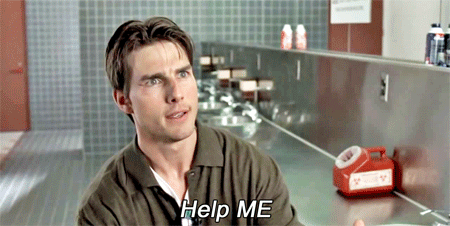
2018 was pretty big, to be honest. I lived in two different hemisphere, travelled through Central America, landed my first full time library job and acquired a surprisingly extensive orchid collection in a very short amount of time.
What it was lacking, however, was some professional development (although, truth be told, I did go to a conference right at the beginning of the year. I merely spent the whole time suffering from an extensive bout of imposter syndrome) . Now, clearly I did develop professionally- internship to a full time role is not something that a lot of my fellow interns immediately stepped into. But I want some fresh lines on my CV. I want the capacity to PROGRESS. I have come this far this fast and I am throughly uninterested in loosing momentum now.
This is exacerbated a little by the fact that, although I love my job, I have all these skills that I do not get to use. And I really want to use them, in case I loose them. Having been in management roles in my prior career path and am now very far down the pecking order is also mildly frustrating (although it’s also very nice to walk away from things at the end of the day, safe in the knowledge that it’s all very low level and nothing will catch on fire. Metaphorically speaking).
An odd bit of random feedback that I was given was that I maybe too lowly to obtain the kind of PD that I was craving (going to conferences, writing papers, doing the academic equivalent of gadding about town). On one hand, I can understand this train of thought, but on the other... WHAT?! The concept that there is some sort of threshold that would magically prevent you from _getting better at your job_, as well as _giving more to the organisation that employs you_ is fundamentally flawed.
I came into my roll a little bit too far into the financial year for any of my PD dreams to come true in 2018 (budgets and all that jazz), but I have both a better understand of the processes and have put it front and centre of all my goal documentation, so all my ‘i’s and ‘t’s should have the requisite parts. Come on, 2019. Don’t let me down.
2 notes
·
View notes
Text
The birth of a horror fan
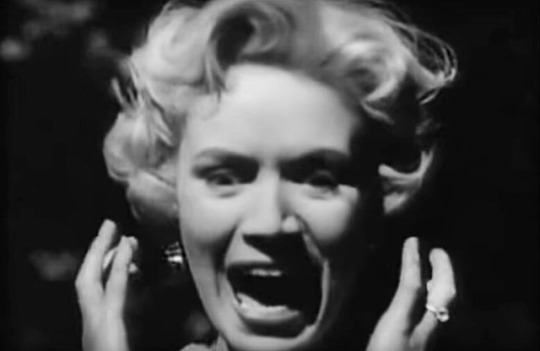
Still of Veronica Hurst as Kitty Murray in The Maze, 1953
I’ve watched 36 horror films in 26 days! For those that know me, this is a lot. For the first time I’m taking party in 31 days of horror. It’s not over yet, I have more horror films to see before the end of October. Viewing this many horror films in less than a month is a record for me!
I never thought I would call myself a horror fan. In the past I would occasionally watch horror films, usually hiding under blankets or peaking through fingers.
Why do some horror films scare me more than others? Is it imagination, sensitivity, suggestibility, tension, violence?
I’ve approached 31 days of horror with a clear plan to watch horror films released between 1900 and 1959. The films I’ve watched are rare, classics, beautifully crafted stories, and the images stay with you.
I’ve noted some interesting recurring themes and plot devices such as newspaper headlines; supposedly dead bodies sitting upright in the morgue; religious figures fighting evil; ‘What a strange man’ is often said; scientists meddling with nature features; cats hissing as a warning (take heed!); Scotland Yard is useless in dark times.

Still of Fay Wray as Eve Trowbridge in The Most Dangerous Game, 1932
I’m now a fan of the original Scream Queen, Fay Wray. She adds depth and sensitivity to the damsel in distress leading lady. She often finds courage and strength in her characters. If you’re not familiar with Wray’s work, check out: Doctor X, dir. Michael Curtiz, 1932; The Most Dangerous Game, dir. Irving Pichel and Ernest B. Schoedsack, 1932; and The Evil Mind / The Clarvoyant, dir. Maurice Elvey, 1935.

Still of Norma Eberhardt as Rachel Mayberry in the Return of Dracula, 1958
Female empowerment has been a theme I’ve relished. Women taking control, showing courage and ingenuity in films like: Cry of the Werewolf, dir. Henry Levin, 1944; She-Wolf of London, dir. Jean Yarbrough, 1946; The Return of the Vampire, dir. Lew Landers, 1943; The Return of Dracula, dir. Paul Landres, 1958; Island of Doomed Men, dir. Charles Barton, 1940; The Maze, dir. William Cameron Menzies, 1953; Phantom of the Opera, dir. Arthur Lubin, 1943.
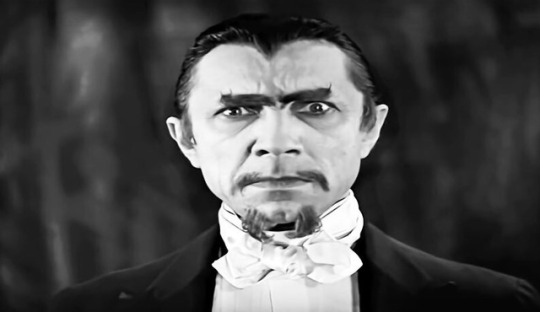
Still of Bella Lugosi as "Murder" Legendre in the White Zombie, 1932
I’m becoming familiar with the work of some of the greatest actors of the genre. I’ve seen lots of Bella Lugosi films: Dracula, dir. Tod Browning, 1931; White Zombie, dir. Victor Halperin, 1932; Son of Frankenstein, dir. Rowland V. Lee, 1939; Black Friday, dir. Arthur Lubin, 1940; The Wolf Man, dir. George Wagner, 1941; The Return of the Vampire, dir. Lew Landers, 1943. Boris Karloff co-starred in many films with Lugosi, but was a star in his own right. I’ve seen more Karloff films: The Mummy, dir. Karl Freund, 1932; The Ghoul, Dir. T. Hayes Hunter, 1933; The Black Room, dir. Roy William Neill, 1935; Son of Frankenstein, dir. Rowland V. Lee, 1939; Black Friday, dir. Arthur Lubin, 1940; The Devil Commands, dir. Edward Dmyryk, 1941.

Still of Boris Karloff as Ardeth Bay / Imhotep / The Mummy in The Mummy, 1932
With only a few days left of October, I’m already planning the films I might watch next October. 31 days of Australian horror films? I’m not sure yet, but I will certainly have fun when I get there. Beginning something, challenging myself, learning, enjoying the adrenaline of being scared, laughing and sharing these films with others, I’ve enjoyed discovering some truly incredible films.
Beginning is the theme for newCardigan’s GLAM Blog Club this month.
#glamblogclub#glam#ausglamblog#archivist#museum archivist#glam blog club#newcardigan#glam geekery#horror#horror films#classics#31 days of horror#halloween
5 notes
·
View notes
Text
Strange GLAM Packages on my Doorstep

The GLAMBlogClub theme this month is Strange and I have been wracking my brains for cool and unusual stories. I toyed with the idea of of the odd stories that come up in and around collections- like the secondary archives at Longwood being stored in a former bowling alley, which was next to a giant underground aquarium. Both of which were removed when the garden’s illustrious leader remember that he didn’t like sports and keep fish alive and the tank leak free reached deep into the too-hard basket. Or the delightful children’s book on womens suffrage which I digitised recently, where none of the character have hands or feet, but can still make signs and steal airships. However, the Universe has thrown up a strange little tidbit, which I thought I would share.
Today I got a mysterious package. It was hiding under my doormat and I also missed it on my egress inside my abode. But there it was, a flat parcel, sent by airmail from the US. Now, I had order nothing, and I assumed it was missent or some sort of trick. But my name and address is on the label, as well as the University I work for.
Curiosity peaked, I opened it to find a copy of the Louis Comfort Tiffany Foundation 2017 Awards Catalogue. Which is BEAUTIFUL and an ABSOLUTE DELIGHT. But it lacks any form of note or explanation. I don’t know how I have this stunning object, and this means that I am certainly not sure about how to make it happen again (which would be very nice indeed).
Manners suggest I need to thank someone- I have sneaking suspicion that this might be link to the ARLIS/NA lists I am on, as part of my conference attendance earlier this year. But I just do not know and am unsure who to ask to find out. It’s a (completely gorgeous) puzzle, wrapped in an enigma and totally made my day. The G in GLAM really does bring a sense of style and wonder to the party.
So strange and so very good.




2 notes
·
View notes
Text
Livin’ in a Digital World (and I am a Digital Girl)
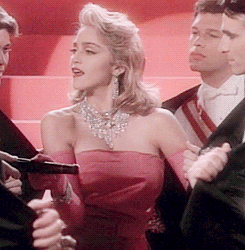
Working in digitisation, you would think that I would be slightly quicker off the mark with this blog post. Ha! I laugh in the face of blogicspherical deadlines. HA!
For the most part- it is difficult to know where to start. The sheer volume of digital born content created in one day would probably keep a small swarm of archivists happily employed for a year. But not all of it is relevant, and there is possibly some sifting the wheat from the chaff (let’s not keep those vaguely racist comments from your embarrassing uncle in perpetuity, shall we?). Therefore the usual conversations about collection management comes into play, and you are left wondering whether digital and physical collections are actually any different at all.
Which is... misguided. Now, dear reader, you may think that I have lead down an odd garden path. And it’s quite likely that I have, but trespass on my time a little bit longer. Because I am going to talk a little bit about discoverability.
Today I got a little bit of a tour of my work’s rare book collection. I am meant to be working with these materials for digitisation, so I was having further training on correct handling and getting expert advice on some (metaphorically) sticky issues I had come across thus far. The rare book collection is sizeable (170,000 items approx), and some of these are too delicate to handle and catalogue. So they have the whole collection in the system as one item and have expectation that any researcher will have a better idea about where in the ‘run’ of books their information will fall. Not the most helpful, it’s true. But if you are coming into the realm of rare books, you are going to have a more exacting idea about what you need and a little bit less of randomly browsing the shelves.
One of the most interesting things about studying Information Architecture was it’s ability to break down different searching techniques/concepts: like the information drag net when you have no idea what on earth you are looking for, the smaller net search when you have some idea but not a particular thing you are looking for (most of my uni research feel under this heading), the perfect catch of a defined question with a defined answer and finally, Moby Dick, that perfect thing which you can never find again. Prior to working in these digital environments, I don’t think that I ever really thought to closely about how I searched for things. But when you are using non physical spaces, you kind of have to break down these processes in a way that we have not really done before.
The key to digital world is discoverability. Unlike the rare books collection, where things are zoned into area that the librarian can understand as assist you with navigating, the digital collection need to be easily accessed and effective through all the different types of discovery. Which, naturally, leads us to metadata. But I find it interesting that, even as far as we have progress in the world of UX design, we are still having discussions about MARC being too rigid and unwieldy, DublinCore being too flexible and online collection exhibition software that people are trying make it do things that it was never really intended to do. This is not an attempt at being disparaging. One of the beautiful things about GLAM is how resourceful we are in making things work with little to no budget/resources and still get it out to ‘the people’. But all this information that we are making, all this lovely content that we are archiving/preserving/providing is almost hobbled at the gate with systems that were generated when the technology was less agile.
No doubt, a lot of keeping on with these practices is to do with the fact that if we change things up, access would be lost for all the pretty treasures that came before. But we have to, at some point, find a better solution then what we have going on at the moment. Books have not changes in essentials at any point since Dewey or Library of Congress systems came into play. But digital is not static and therefore I am not entirely sure that we can keep those same process in place. I have no idea that a more agile cataloguing system would look like. Probably quite terrifying. But made it’s time to stop trying to fit things into what we have and think about what we really need.
2 notes
·
View notes
Text
The Importance of Being Creative

I have always enjoyed making things- it’s my great stress reliever. Sometimes.
Currently I am in a bit of a creative rut, as I have a project that I need to finish and therefore refuse to create anything until it’s done.
And, in truth, it’s only a few hours off completion.
It was meant to be a gift as a celebration of an impeding familial addition. Only that addition is no longer pending. It arrived months ago and I am still staring at this project. The issue is, I do not like it. I spent ages trying to find the right pattern, once found, it took me ages to get the right cotton. Then the pattern, no matter how much I pulled it apart and put it back together, did not look the way it was meant to. I eventually just decided that I was happy enough with the approximation and proceeded with the project.
I have been making these sorts of craft projects for as long as I can remember. I have my original test knitting squares, which were, although increasing and decreasing randomly, was not a sea of drop stitches and still holding together through the eons of time that how now passed. But this moderate rectangle of swaddling materials as oddly changing tensions, curved shapes and different lengths rows that are both unusual and unnatural. I have never made something so ‘failed’ from beginning to end.
So periodically I sit down, pull it out and ponder. Is this something I can fix? If so, how can it be done? Would it be better to completely pull apart a couple of month’s worth of work and start again? I mean, it’s already late. And, as I ponder these possibilities, I shuffle through the outcomes. Will the recipients care that it’s all a little wonkus? Probably not, but I do (which is a whole other blog post). It’s cotton, so maybe I can stretch it out, but it might look more weird. Why do I have so much cotton left over- could I add more stitches? Etc, etc. But none of this musings are satisfying enough to commence the completion of the project.
It did occur to me today, as I was wading through some ongoing technical issues at work, that these creative processes really assist me in trouble shooting. Because creating is very much not about perfection (although lovely and definitely something to strive for) but very much about the process of learning to make the best of your mistakes. And it means that I was standing in front of a digitisation set up, and yet not freaking out about hitting the ‘wrong button’, willing to give different options a crack and seeing which of these results would best suit the project’s needs.
I think people have become more terrified of mistakes than they should be. No one (unless their are part of the Greek Mythos) leaps into the world fully formed, and yet we have this unreasonable expectation we will offer representations of perfection all day, everyday. But without making any mistakes, you don’t learn, you don’t get wise and you can’t see all the possible options for resolution and change. You only see the beginning and the end, not the process in between. I imagine that, should you ever stray form that clearly defined pathway, this carefully constructed world might crumble. But maybe I am being melodramatic.
In the creative process something always unexpected happens and it’s much more about working with these serendipitous surprises/knotty problems/inconsistencies and getting to a point where, although it may not be the piece of work that you envisaged at the beginning, is still something to be proud of in the end. Get comfortable with the fact that mistakes happen- sometimes they can be really beautiful (or people can still appreciate the thought process behind them).
2 notes
·
View notes
Text
Create, the passion
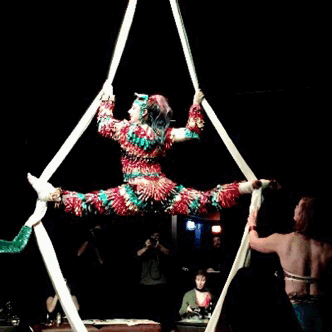
Gif from a video I shot of KillJoy performing at Dr Sketchy’s at 24 Moons, 14 September 2017 © Nik McGrath
I’m passionate about my job and the GLAM sector. GLAM isn’t my one and only passion. A benefit of having many alternative passions is they help sustain my passion for GLAM.
I feel passionately about the importance of GLAM workers having interests outside the world of GLAM. I believe we keep our passions alive at work, and within the GLAM community, by having passions outside work.
Passions outside of GLAM may fuel our discovery, innovation, ideas and inspiration at work. Ideas and ways of doing things in other areas may help resolve challenges we are facing at work.
I use a lot of emotional energy in my work. Self care is important. Drawing is one of the only times I really let go of the thoughts constantly rattling away in my mind. Drawing is my main form of self expression and relaxation.

My sketch of a model performing to the theme Vampyros Lesbos at Gay Life Drawing at Hares & Hyenas, 13 March 2018 © Nik McGrath
I enjoy all forms of art - performance, music, visual art, film, dance, photography... I often think that one day, when I retire, I will have a full life because of all of these passions that I have to sustain me. That comforts me.
Passion was the theme for GLAM Blog Club in May. Create is the theme for June. One blog, two themes.
1 note
·
View note
Text
Secret about a secret
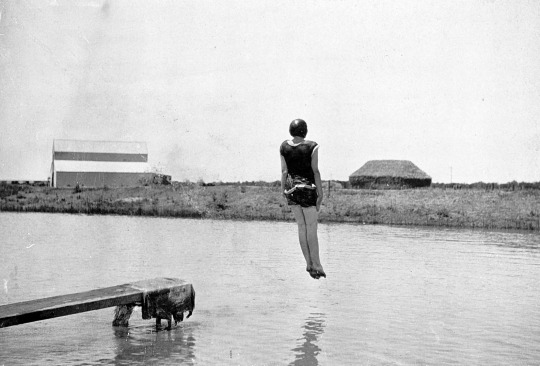
A young girl jumping, feet first, into a dam, Mildura district, 1924 / Photographer unknown / Source: Museums Victoria, Item MM 5035
“A photograph is a secret about a secret. The more it tells you the less you know.” – Diane Arbus

Phyllis and Jeffrey Louey Gung outside the Royal Exhibition Building, Carlton Gardens, Melbourne, circa 1948 / Photographer unknown / Source: Museums Victoria, Item MM 136700
Photographs of people are a source of happiness for me. The more I look into a photograph and think, why was the photograph taken, was the subject exploited or misrepresented, my initial happiness can go two ways. I can either become obsessed about finding out more about the subjects and context of the photograph; or I can simply enjoy the photograph for the aesthetics and intrigue it provides.
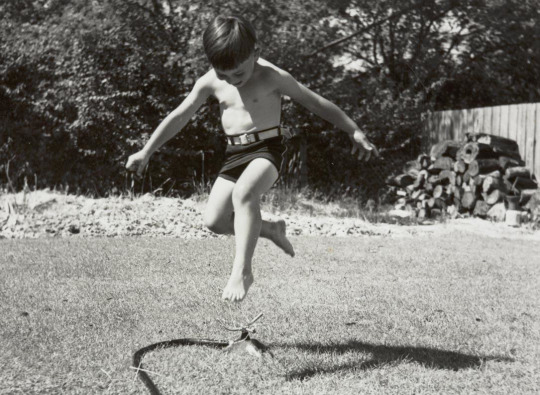
Gerald Brocklesby jumping over the sprinkler in the back garden of his family home at Blackburn, 17 January 1953 / Photographer: Mark Linacre Brocklesby / Source: Museums Victoria, Item MM 110316
With more photographic collections digitised and made accessible online, more than any other time in history we have access to these remarkable photographs from collections all around the world. This also makes me very happy.
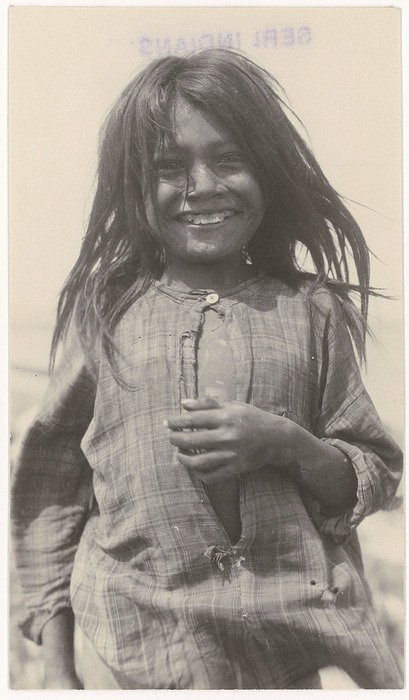
Outdoor portrait of a smiling girl, Isla Tiburón, Mexico, 1924 / Photographer: Edward H. Davis / Source: National Museum of the American Indian, P06267
This month’s newCardigan GLAM Blog Club theme is happiness. Photographs sometimes capture the happiness of the subject. Is it true happiness captured? Often when a camera is pointed at a subject, the subject will automatically smile or laugh for the photographer. Are they happy to have their photograph taken, embarrassed or conditioned to smile for a photograph? Is happiness contrived?
#glamblogclub#GLAM Blog Club#glam#AusGLAMBlog#archivist#photographic collections#photographs#portraits#museum collections#happiness
2 notes
·
View notes
Text
Private moments
Voyeurism is part of the job. Reading correspondence, private diary entries, works in progress.... I watch private moments in the archives.
I wonder if the author of these private moments considers when writing that these moments are in fact not private. They belong to the organisation they work for, and will be studied in years to come. If the author is aware, does this alter their mode of expression?
In the Museums Victoria Archives, correspondence between experts working in the same field but different countries, over many years, the lines are blurred between professional exchanges and the personal friendships that form. Family holiday postcards are exchanged, and filed dutifully along with correspondence on museum letterhead. The sense of watching is felt keenly.
Museum experts receive letters from interested members of the public, all kinds of enquiries that are each dutifully responded to in turn. As the Museum has grown, so has the number of enquiries. Now a unit in the museum fields these enquiries and logs them in a central database. No enquiry is ever allowed to fall between the cracks. A great deal of work goes into providing access to information, collections, experts and answers.
In 1988 a 9 year old girl wrote to the Museum of Victoria about her stamp collection, her interest in stamps, and declared that “... collecting stamps is one of my best hobbies”. The girl also asked for information on collecting stamps and asked if the Museum could send her some. Such a tender and heartfelt moment, which could have been easily crushed if the girl received no response from the Museum, or received a short and sharp response. Thankfully John Sharples, Curator of Numismatics, did not disappoint. In fact, Sharples letters never disappointed, he always gave kind and informative responses to all his correspondents.
Sharples replied: “Thank you for your letter about your stamp collection. Unfortunately the Museum has no printed information on stamp collecting that I can send to you. We have only a small stamp collection from the period when stamps were first used in Australia”.
Although Sharples was unable to provide information about stamp collecting, and could not send the girl any stamps, he was still encouraging: “May I suggest that you visit your local library and ask the librarian to show you where the books on stamps are kept”.
If I was the girl who received this letter, I’m sure my love of stamp collecting would have been inflamed by such encouragement. Sharples final encouragement: “Stamp collecting is indeed a good hobby and I hope that you continue to enjoy it for many years”.
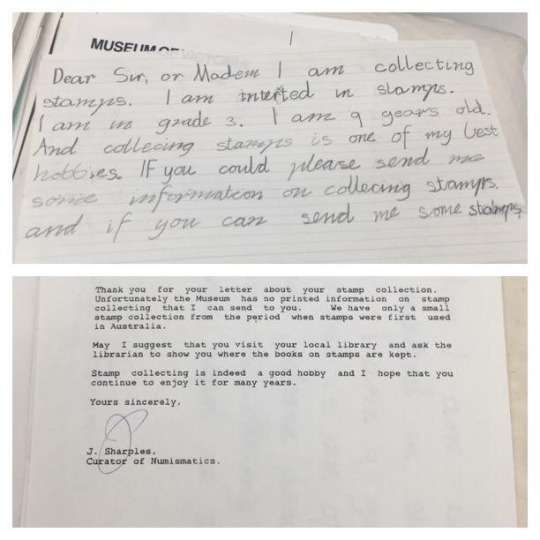
Above cropped image of letter from unidentified girl addressed to the Museum of Victoria, and below reply from John Sharples, Curator of Numismatics, 1988 / Photographer: Nik McGrath / Source: Museums Victoria Archives
This is just one example in a sea of private moments contained in the Museums Victoria Archives. I feel privileged to witness these moments. These letters feel fresh, indeed 1988 is recent history. In fact I was 7 turning 8 years old myself in 1988. This letter could easily have been written by me. I too had a stamp collection which was one of my prized possessions.
I have protected the identity of the girl in sharing this letter online. I wonder if she might see this blog and remember writing the letter.
Private moments are recent, and also distant memory. Letters written over 100 years ago, the ink bleeding into the soft tissue paper, paper folds cutting into the fragile paper, bring to life moments that feel like they happened yesterday.
‘Watch’ is our theme for newCardigan’s February GLAM Blog Club. I never realised how much watching and voyeurism is an essential part of my job.
#glamblogclub#GLAM Blog Club#glam#GLAM geekery#AusGLAMBlog#archivist#museum archivist#Museums Victoria Archives#Museums Victoria#correspondence#archives#watch
4 notes
·
View notes
Text
Wolf pack
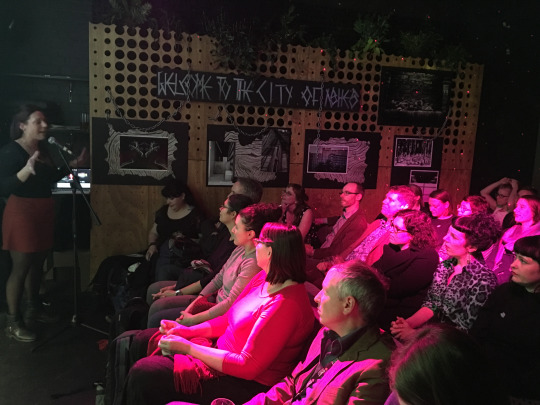
Mel Begg speaking to cardies about horror film archives, June 2017 / Photographer: Nik McGrath
“In the long history of humankind (and animal kind, too) those who learned to collaborate and improvise most effectively have prevailed” (Charles Darwin, The Origin of Species, 1859).
Collaboration is from the Latin ‘collaborare’, meaning ‘work together’. At the heart of what we do as GLAM (galleries, libraries, archives and museum) professionals is collaboration, that is if we don’t act as lone wolves, if we reach out to our colleagues in the GLAM sector. My wolf pack are my friends and colleagues in the GLAM world. I also have a wolf pack in the art world, and a recent wolf pack in the Melbourne Horror Film Society (MHFS).
Sometimes these wolf packs cross over, and my fellow wolves that belong to more than one of my wolf packs are truly special people in my life who I can collaborate across areas of interest. Mel Begg and I studied Information Management at RMIT together, drawn together as fellow archivists interested in film, audiovisual and photographic archives. Mel is one of the organisers of the MHFS, introducing me to the group. Earlier this year I asked Mel to talk about horror film archives at our June cardi party. I love when worlds collide.
In recent years there has been increased cross-disciplinary collaboration between the GLAM sector. If lone wolves were how we operated in the past, current practice encourages collaboration to add value to our profession and the community we serve.
“Now in the digital world, collaboration is central, contributions are encouraged (blogs, tweets, share photos and videos, post content to Facebook, and so forth), and people recognise that sharing adds value for everyone” (Joseph R Matthews, Adding Value to Libraries, Archives, and Museums: Harnessing the Force That Drives Your Organization’s Future, 2016, p. 215). When you post a blog, you are contributing your thoughts to a larger discussion online. That’s what GLAM Blog Club is all about. I think collaboration is an apt theme to close the year, and something newCardigan supports in everything we do.
Collaboration has been important to me as long as I can remember. I think for me it really started in art class at school. To create my photographs for my year 11 and 12 folio, I collaborated with life models. I contacted the local life model society, hired a model to come to my house, spoke to the model about my ideas and we discussed the best way to execute them.
Returning to uni to study Information Management, I was blown away with the level of collaboration amongst the student cohort. During our studies a couple of the students created a Facebook group for us, Li-BRO-rians, although I’m an archivist and not a librarian, I was still a welcome member of the group. We discussed uni assignments, shared ideas and worked together to navigate the course the best we could. When we began to apply for jobs, the support of this group was crucial to everyone’s success, and continues to be so.
When I was asked to join the cardi core (committee) of newCardigan, I would never have thought how much I crave collaboration. Collaboration with the cardi core, GLAM speakers and our cardies (members) is central to the success of our cardi parties, cardiCast (podcast) and GLAM Blog Club. Collaborating, cross-pollination between different personality types, experiences, skill sets and professions in the GLAM sector is essential to improve and implement our ideas. JFDI is newCaridgan, and collaboration is how we’ve maintained momentum.
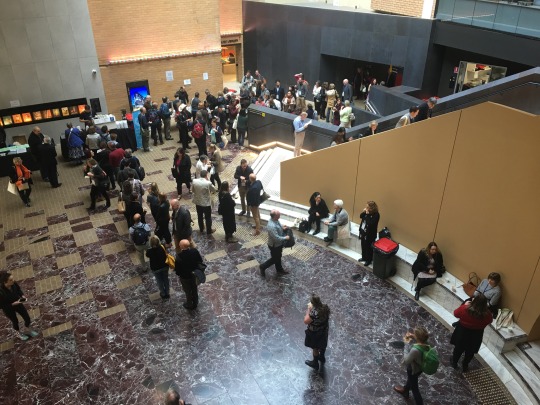
Australian Society of Archivists conference delegates, September 2017 / Photographer: Nik McGrath
I learn a great deal from collaborating with others. Projects benefit from the input of ideas from more than one source. The newsletter I produce as Comms Officer of the Australian Society of Archivists (ASA) Victorian Branch requires the collaboration of many voices to make each issue an interesting read for members of the GLAM community. I enjoy reaching out to individuals inviting them to write feature articles, and receiving articles from passionate members of the Branch who want to make a contribution.

Friends drawing at Dr Sketchy’s, August 2017 / Photographer: Nik McGrath
In December 2007 I went to my first Dr Sketchy’s at the Butterfly Club in South Melbourne. Since then I have been a regular member of the Dr Sketchy’s art community in Melbourne. I have met many incredible performers and artists over the past decade. Each Dr Sketchy’s session is a collaboration between the artists in the audience and the performers on stage. It’s an important working relationship that leads to the creation of memorable experiences, sketches, videos and photographs.
In recent years I have been an active member of the Covert Characters Life Drawing group, collaborating with performers when making drawings and photographs, and feeling inspiration from the performers on stage, the feeling in the room, and my fellow artists. This inspiration and collaboration is something I also feel each time I’m with my Dr Sketchy’s art family.
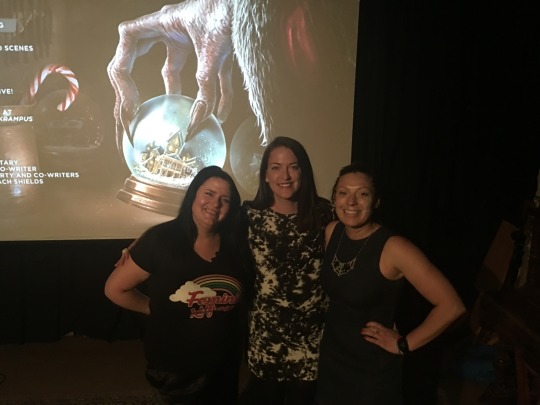
Terri Berends, Mel Begg and I at a Melbourne Horror Film Society screening, December 2016 / Photographer: unknown
I think we grow stronger from collaborating with others, we learn and feel inspired. I love being surrounded by cinephiles, sharing in their passion for film. For many years I have immersed myself in the world of sic-fi and fantasy, however recently joining the Melbourne Horror Film Society, attending monthly screenings and learning more about horror films from the organisers and members of the society, I feel like I have a new-found appreciation for film as an art form. The collaboration of the organisers, and being an attendee rather than an organiser, allows me to learn from their way of doing things, their knowledge, ideas and passion, in a different way than in my role with newCardigan and the ASA VIC Branch.
As a museum worker, I collaborate with individuals across the organisation, in different departments, on various projects, and in various types of work. I work closely with colleagues in the Records and Archives unit to deliver various projects, recently we have been working on the upgrade of our EDMS. I also collaborate with members of my department which includes the library team and the public information team. Recently we collaborated with the library team to create library and archives tours. In the tours we presented correspondence between famous English ornithologist John Gould and the first Director of the Museum, Prof Frederick McCoy in the archives, and the library rare book collection of Gould publications, including Birds of Australia and Birds of New Guinea. Collaborating on the these tours meant that visitors received insights about the beautiful Gould publications from the librarians, as well as telling the story from the archives of how the Gould publications and specimens were collected over a number of years.
When the public information teams send research enquiries from a member of the public to me in the archives, the same question is often sent to another member of staff, perhaps a collection manager or curator. To answer a research question often requires information from many sources across the Museum. If only one person answered the enquiry, the full picture would not be discovered. Collaborating on research projects across disciplines and areas of expertise is something that benefits everyone, especially the person asking the question in the first place. The Museum recently received an enquiry about Frank Spry, an entomologist who worked in the Museum in the early 1900s, who collected items for the entomology, palaeontology and ethnology collections. This enquiry has led to a collaboration project between colleagues working in Entomology, Palaeontology, Indigenous Cultures and Archives, and will eventually lead to a better understanding of Frank Spry and his contribution to the Museum.
Collaboration is at the heart of what we do as GLAM workers. Archivists in the past were often described as lone wolves. Today we are part of something bigger, the GLAM community. Collaborating on projects, cross-pollination across disciplines and working with others creates learnings across the sector, better and more rounded individuals in the profession, and more fruitful and well-rounded GLAM programs, exhibitions and experiences.
#GLAM Blog Club#glamblogclub#glam#archivist#artist#museum#Museums Victoria#Melbourne Museum#newCardigan#cardiparty#cardicast#blog#Dr Sketchys#Covert Characters#art#collaboration#collaborate#photographer
2 notes
·
View notes
Text
Walking a tight-rope

Ivy Baldwin crossing Boulder Canyon on a tightrope, 1907 / Photographer: unknown / Source: Robert N. Dennis collection of stereoscopic views, Colorado, New York Public Library
Do you ever feel like you’re walking a tight-rope? Future gazing and workplace planning are important tools to achieve goals. If a work-plan reflecting all of the important components of your role within an organisation is created and implemented, it is indeed possible to find balance between these components.
This month’s newCardigan GLAM Blog Club theme is balance. The idea is that you can interpret that word in any way you like. Instead of looking at work-life balance, or another meaning of the word balance (I did consider sustainable collecting), I have chosen to consider the balance I strive to achieve everyday in the work I do, with a sense of duty in meeting the requirements of my position.
During the interview process for my current position as archivist at Museums Victoria, I was asked to present my vision of the first 12 - 18 months in the position based on the position description supplied. When reading the position description, I saw a need for balance between the twelve objectives listed.
As all archivists do, I immediately saw a need to classify the objectives into functions, then sought to divide each week into fragments of time based on the priority I placed on each function. The twelve objectives were divided into five main functions: access; storage; collection management; governance and legislation; and finally, a volunteer and student program.
I noted that access would be given priority, as I feel strongly about promoting archival holdings to ensure increased accessibility, not only to researchers but all members of the community. The position is four days a week, and thus I divided my week into one and a half days spent responding to research and access requests; promoting archive material for publications, exhibitions, and online; developing finding aids; identifying vital records; and developing a digitisation plan.
Storage, given second priority, I assigned a day a week, including appraisal and disposal work; managing the space requirements and resources of the repository; and monitoring environmental conditions in the repository.
The last three functions I equally divided into half a day each per week. Collection management has one main objective, to work with stakeholders to manage archive holdings across collections and institutions. Collection management is a larger function including storage, facilities management, preservation and conservation requirements, ordering archive supplies, and the list goes on and on. I consider the job of archivist closely aligned to that of a collection manager.
Governance and legislation has two main objectives: to adhere to Museums Victoria’s policies and procedures; and to adhere to relevant archives legislation and regulations. This often requires the development of internal policies and procedures, and to update existing ones. It’s also important to stay up-to-date with any changes in industry legislation and regulations.
A volunteer and student program, is the last of the five functions, which includes training and supervising other workers, students or volunteers on projects in the Archives. I find all aspects of my work extremely rewarding, working with volunteers and students, helping them learn new skills and seeing them flourish, makes me feel that I am positively contributing to the GLAM community and advocating for the role of archivists in the workplace.
Some weeks I feel that I achieve a balance between these functions, and other weeks one function may take priority. However, these functions are a guide for me to revisit regularly. I often consider, am I servicing each function as I should? Am I giving priority to one function when needed? Am I finding balance between all of my functions as an archivist?
Walking the tight-rope that is my life as an archivist often requires a long view, planning projects based on the priorities of the organisation, years into the future. It is easy to get lost in the legacy that is archival work, and the volume of work ahead. However, I feel that dividing and conquering, seeking a balance in daily and weekly tasks, helps manage and find balance in all of the functions that make up the role of archivist. Walk that tight-rope, and don’t look down.
#GLAM#glamblogclub#AusGLAMBlog#archivist#museum#collection management#balance#workplan#planning#access#storage#governance#legislation#volunteers#students#mentoring#community#priorities#Museums Victoria
1 note
·
View note
Text
The Road Less Travelled Part II

How did she end up here, like this? How could there have been so much - so many moments, so many people and things… - Everything is Illuminated, Jonathan Safran Foer
In January this year I wrote a blog The Road Less Travelled, sharing my path to becoming an archivist: https://musingsofableedingheart.tumblr.com/post/156377570259/the-road-less-travelled-like-many-people. My archivist origin story is well covered in this blog, however I would like to add some more thoughts about ‘How I ended up here’ for this month’s newCardigan GLAM Blog Club.
When I became an archivist, I found my vocation. For as long as I can remember I have been obsessed with history, photography, art, material culture and piecing together narratives based on evidence from primary sources. As a museum archivist I have access to collections that feed my obsessions, and I receive many research enquiries that requires the piecing together of narratives based on archival evidence.
An example of piecing a narrative together is my research about the scientist Fay Murray. In December last year I received a public enquiry via the Discovery Centre at Melbourne Museum about Fay Murray from her nephew Reg Murray. Reg contacted the Discovery Centre about his aunt seeking information for the family history he is compiling. With the information that Reg supplied to the Discovery Centre, namely that Fay was a scientist who specialised in molluscs, in the 1950s to 60s, I immediately thought Fay may have worked with Hope Macpherson, who was Curator of Molluscs at the Museum during that time, the first female museum curator in Australia.
Fay’s story is particularly touching as she had rheumatoid arthritis, and overcame much adversity to pursue her love of science. With the help of Chris Rowley, Collection Manager in Marine Invertebrates, I have uncovered a great deal of information about Fay in the Archives, correspondence between Fay and Hope (1956 to 1964), I’ve interviewed her former colleagues (Bob Burn and Tom Darragh), inspected items Fay donated to the State Collection, and looked at her photographic slides (she was a gifted photographer), as well as corresponding and meeting with Reg Murray.
Chris and I took Reg to see the specimens Fay donated to the State Collection in the 1960s. Reg has sent me family photos of Fay and her siblings, and is still in contact. I will be publishing an article about Fay on the Museums Victoria website in the coming months.
Bringing personal stories to life from the archives is a passion of mine. I started out studying ancient history and art history after finishing high school and commencing my Bachelor of Arts at the University of Queensland. My passion for history remains strong all these years later. As an ancient historian, seeking primary sources was an important part of my education. To this day, I get a thrill each time I find out something important about my subject’s life from sources within the archives.
Another reason my path led me to archives is my passion for photography. Photography presented itself as a lens through which to see the world and a method to document aspects of my life and experiences. From my first experiences in the darkroom at high school, to my experiments that continued in the darkroom studying graphic design at uni a few years later, I grew a firm attachment to the art-form, which then gave me special insights into cataloguing photographic collections years later when my path led me to studying cultural heritage and later information management.
I see myself first as an archivist, and second as a photographer. However these two inextricably linked and interwoven elements of my vocation inform each other. My keen observation skills as a photographer allow me to see and observe important small and significant elements in the archives, and my attention to detail as an archivist describing items in the archives I bring to documenting metadata about my personal photographic collections. The archivist and the photographer in me understands the importance of documenting important moments that I will treasure in years to come. The family photographic archives are my responsibility, in many ways I know the digitisation, storage and access is solely expected of me by members of my family.
How I ended up here is a long and complicated story, with many strange twists and turns along the way. In some ways it was inevitable that I became an archivist, but in other ways I feel it was equally possible that I became a marine mammalogist travelling the worlds oceans, or a photographer hoping to live off my trade, a graphic designer selling my soul to the highest bidder, or an ancient historian seeking a new interpretation of a primary source that would wow classical historians, or an art historian breaking down stereotypes in the art world.
So many paths that I could have taken, but for some cosmic reason I was granted my dream job as a museum archivist, and I find myself in my vocation during an extremely exciting time where GLAM colleagues are collaborating on some of the most inclusive and innovative projects. I feel inspired and fortunate to find myself in this moment in time with such incredible people surrounding me.
2 notes
·
View notes
Text
Horror Hamlet
Hamlet is my favourite Shakespeare play, which has been the case since high school. I’ve seen many interpretations of Hamlet over the years. I remember seeing Heavy Metal Hamlet in the Botanic Gardens in Brisbane when I was still at school, which left a lasting impression. I saw Kenneth Branagh’s 1996 version of Hamlet in the cinema, which no doubt has influenced my interpretation.
I've been going through some old boxes, and found some journals from school, hence my nostalgic mood.
Do you have a favourite teacher from your school years that you still think about fondly? Well, my favourite teacher was Ms Poulsen. She had purple hair, loved Joy Division and let us stencil poetry on the classroom wall. She was very encouraging, passionate and an inspirational teacher. I still have the letter she wrote to me at the end of grade 12, and the bookmark she picked for me personally. She really cared about her students.
Ms Poulsen set us a task in grade 12 English to interpret Hamlet and write in our journal the ideas outlining our film version of Hamlet as director of the production.
In August 1998, when I was 17, I wrote my Director’s Address, which I’ve had a kick out of reading today, and I thought others might too.
‘The vision of Hamlet that I intend to direct is an R18+ horror film. Hamlet is a particularly violent play so far as the emotions of some of the characters express.
I wish to bring this out with sound and special effects. For example, the scene in which Polonius is slain by Hamlet, Hamlet could cut Polonius’ head off so that blood splatters on the walls and his head rolls off, and in his last breath of life the head attempts to bite Hamlet’s leg. His jaws clamp on tight and are difficult for Hamlet to remove [I was a bit obsessed with Jaws]. Gertrude may be hysterically screaming for what she has witnessed, and horror that Hamlet would turn on her next.
Words spoken to Claudius by Hamlet could be ones of complete verbal abuse - swearing, intimidation and veins popping in the neck. Hamlet could be a chain smoker displaying the stereotypical belief that people smoke in order to calm their nerves.
When Ophelia drowns it may be a struggle to survive with ranting and raving.
The final scene in which people are poisoned could induce projectile vomiting and blood spurting out of the mouth and ears. Violent palpitations could follow death. The room in which Gertrude, Laertes, Claudius and Hamlet are poisoned would be covered in vomit and blood.
The cast of my film version of Hamlet, if I had a choice and availability of any actor/actress I wish, would be the following: Hamlet - Gary Oldman; Ophelia - Jennifer Ehle; Claudius - Warren Clarke; Gertrude - Emma Thompson; Polonius - John Malkovich; Laertes - Rowan Atkinson (snobbish); Fortinbras - Robert Carlyle; Horatio - John Hannah, Rosencrantz - Rik Mayall; Guildenstern - Adrian Edmondson; and Ghost - Alan Rickman (evil voice).
My interpretation of the play Hamlet is that is is a play of death, the pursuit of death and violence which accompanies death. That is why I have chosen, as director, to make a horror film out of the play. I will be exaggerating the violence which exists so that a horror film will be developed.
My interpretation of the motivations of the characters is as follows: Hamlet is motivated by the thought of murdering his uncle; Ophelia is motivated by the love she feels for her family and Hamlet; Claudius is motivated by money, power and Gertrude; Gertrude is motivated by her duty as mother to Hamlet and Queen of Denmark; Polonius is motivated by gaining power and trust in the royal family of Denmark; Laertes is motivated firstly, by returning to France and secondly, by avenging his father’s murder; Fortinbras is motivated by gaining the territory his father lost and by physical violence (pursues war); Horatio is motivated by protecting his best friend Hamlet; R & G are motivated by sucking up to the royal family possibly in hope for gaining an important position; and the Ghost is motivated by ensuring that Hamlet kills Claudius.
My vision for the production of Hamlet in terms of costumes and set is that the costumes be for Hamlet dark and flamboyant. I think I desire something similar to that of Dracula in Bram Stoker’s Dracula (directed by Francis Ford Coppola), of that period.
Dracula was published in 1897, so I imagine the period which will inspire the costumes for my production of Hamlet will be 19th century.
I thought Winona Ryder was beautiful in Bram Stoker’s Dracula, however I wish to cast Jennifer Ehle starring alongside Gary Oldman as Ophelia. The costumes of Mina in Dracula will be idea for Ophelia with Ehle’s face.
Ehle recently acted in Wilde - Bram Stoker and Oscar Wilde were friends!
The castle at Elsinore shall me Gothic in architecture, dark and overwhelming. The rest of the characters will be dressed in 19th century costumes with red as the underlying colour. The Gothic castle I have in mind is of the 12th - 13th century in stone.
To make Hamlet a horror film, certain areas in the plot must be emphasised. The appearance of the Ghost in the opening scene must be absolutely terrifying. Bernardo, Francisco, Marcellus and Horatio must behave as though they truly believe that the Ghost is going to kill them in the most gruesome manner. To make this possible, Alan Rickman’s voice must be at its deadliest and face at his scariest. The special effects must create a feeling of hell fire when the audience views the Ghost for the first time. Devil creatures and demons will surround the Ghost as he has just come from hell itself. A transparent image of Hamlet’s fathers head with dry blood at the ears (where the poison was poured) would be rather shocking. The Ghost must be forceful and threatening on the point that his murder must be avenged.
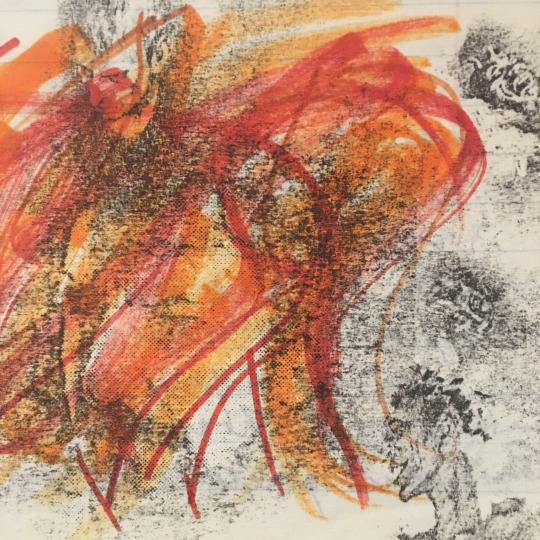
This is the image of hell I portrayed in my journal, with a rubbing of Alan Rickman’s face at the centre and Norman Lindsay’s hellish creatures and Norman Lindsay’s self portrait at the top left
In Act II Scene IV when Hamlet meets the Ghost of his father he must be amazed at the transformation of a person he once knew into some kind of monster [I too was surprised when Metallica released their song of the same name in 2003]. This idea and the entrance of the evil spirit into Hamlet’s soul encourages him to do all that he can to rid the world of his uncle. However, struggle ensues within Hamlet as to how far he shall go for his father’s spirit without acting completely immorally which is against his nature. The Ghost consumes him during acts of violence, such as, in Act III Scene IV when Polonius is slain.
In Act IV Scene V when Ophelia goes mad she must behave out-of-control. The nature of her madness turns to extreme violence to anyone who comes close to her. She bangs her head against the floor and walls and she leaves howling in pain. Her death in drowning is one of thrashing and violence. Screams which penetrate the soul and thanks to the grand sound effects make the audience disbelieve that Ophelia is the same person. Blood spurts from her wounds due to the intensity of her screams and thrashing about.
Act V Scene II the last scene of the play is filled with horror to the climax of the play. The poisoning of Gertrude, Laertes, Claudius and Hamlet involves projectile vomiting and blood spurting out of the mouth and ears. Possibly due to the ingredients of the poison. Violent palpitations follow death.
The camera techniques must involve crystal clear images and many close-up shots of Hamlet’s face so that expressions are important. Swift movement in times of murder and violence will build the effect.
The problem in doing this is justifying the amount of violence. For an audience in 1998 to make Hamlet original and intriguing for this audience, to believe a horror film would be an excellent way to do this, and attract a younger audience who may not wish to be bored by lengthy 4 hour versions which have previously been put out! This does not mean that I do not admire and enjoy the Kenneth Branagh version.’
If you’ve read to this point, thank you for going on this journey down memory lane with me. This month I’m thinking about identity for GLAM Blog Club, and looking into my past is part of my efforts to prepare for writing a blog about myself and who I am.
12 notes
·
View notes
Text
Crashing Waves Through the Wall

The archives repository is silent. Tucked away on the ground floor of Melbourne Museum, back of house, the Museums Victoria Archives shares a collection store with the Museums Victoria Library journal collection. We also share a wall with the Te Pasifika Gallery and when it is silent - no chatting staff or volunteers - I can hear an audio loop of crashing waves through the wall. Without this audio loop the silence is deafening. The excruciatingly load announcement over the loudspeaker, ‘the museum will close in 5 minutes’, also breaks the silence.
The theme for newCardigan’s GLAM Blog Club this month is silence.
After silence that which comes nearest to expressing the inexpressible is music - from essay The Rest is Silence in Music at Night and Other Essays, Aldous Huxley, 1931. Silence is just as powerful as music. Yin and yang, music and silence are opposite forces. When I am alone in the archives I very rarely sit in silence. I often listen to music.
Conspicuously the air conditioning is barely audible. In some collection stores the air conditioning is very loud because the temperature must remain low to preserve the collection. In the archives where the collection is predominantly paper-based, the temperature must remain under 20 degrees celsius and thus the air conditioning gets less of a work out.
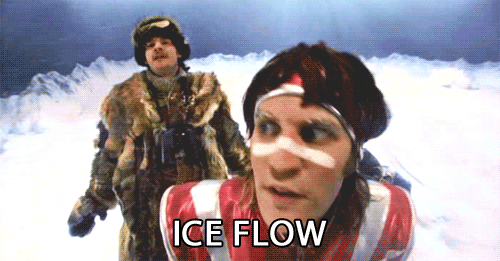
Cold vaults storing audiovisual and photographic collections under 10 degrees celsius are loud places.
So not all archives are silent, but I think it is fair to say that most archives have stories that remain silent. Thousands of voices are in the pages carefully filed away in archive boxes waiting to be given a voice.
It’s the responsibility of the archivist to ensure that the collection under their care is accessible, and to raise the profile of the archives and the valuable information housed within their collection. Archivists create finding aids to give a voice to silent records.
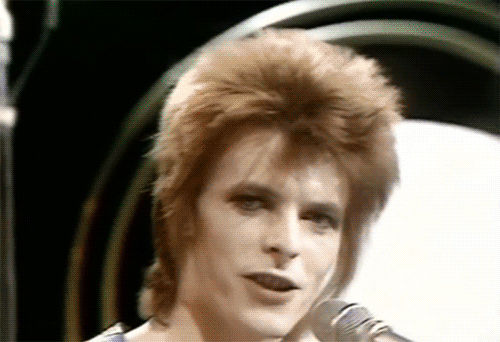
Archives often contain at least one Ziggy Stardust or vital record in their collection. The Ziggy Stardust of the archives will have a voice over and over again through generations of researchers. The unsung heroes, the voices unheard, are often just as compelling as the Ziggy Stardust’s of this world.
If nobody else sees value in these stories, the archivist who knows their collection best has an opportunity to tell stories from the archives in a variety of ways. Archive tours, blogs, seminars, research requests, finding aids, and archival description are just some of the ways.
I love when the museum is bustling with visitors - it’s function is to be enjoyed by the community, it is a sad sight to see it on low visitation days. However, the scale of the building, the endless glass and polished concrete floors are an acoustic nightmare. It is remarkable how sound travels when a kid screams in excitement or in protest. School holidays are something else entirely. I will confess the silence in the museum after hours is ecstasy. For those who don’t often have time alone, it’s akin to those stolen moments of solitude.
1 note
·
View note